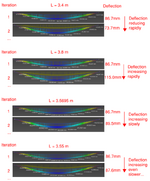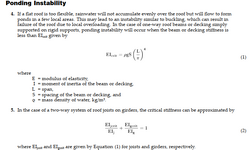There was a previous thread about water ponding on slabs that got me thinking about an interesting problem. I have not had any luck solving this theoretically, so for now it remains just a thought experiment.
Imagine a massless plate with elastic modulus E and thickness t that is simply supported on two edges with span of L and width B (shown in (1)). In its unloaded state, the plate is perfectly flat.
The plate is then subjected to some initial bending causing it to deflect by Δ (shown in (2)), and a liquid with unit weight γ is gradually poured onto it. (Ignore the fact the sides of the plate are open).
Finally, the external bending is released so that only the weight of the liquid acts on the plate (shown in (3)).
Questions:

Imagine a massless plate with elastic modulus E and thickness t that is simply supported on two edges with span of L and width B (shown in (1)). In its unloaded state, the plate is perfectly flat.
The plate is then subjected to some initial bending causing it to deflect by Δ (shown in (2)), and a liquid with unit weight γ is gradually poured onto it. (Ignore the fact the sides of the plate are open).
Finally, the external bending is released so that only the weight of the liquid acts on the plate (shown in (3)).
Questions:
- What happens to the plate once the initial bending is released?
- (A) - Will it spring back to its original flat position, displacing the liquid in the process? Or...
- (B) - Will it settle into a particular deflected shape and achieve equilibrium?
- Is there some critical combination of initial deflection, plate stiffness, etc. that this outcome hinges on?



